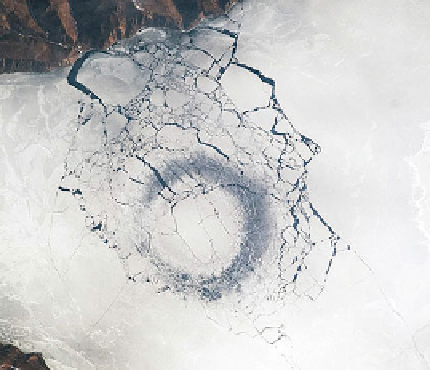Geoscience Reference
In-Depth Information
water and the upward compensating
flow in the lake interior (Mortimer and Mackereth
1958; Kirillin et al. 2012b). Estimations of
fl
flow rates by means of tracer experiments have
revealed the values of 10
−
6
ms
−
1
for the vertical current velocity in the lake interior
(Likens and Ragotzkie 1965) and 10
−
4
ms
−
1
for the downslope sinking in the bottom
boundary layer (Welch and Bergmann 1985). The heat release from sediment was esti-
mated in both cases as 3 W m
−
2
. Using radioactive tracers, Colman and Armstrong (1983)
have estimated the average horizontal mixing rate as 4.7
fl
10
−
5
m
2
s
−
1
. This means that
×
the length scale of diffusion is 2 m in 1 day.
Since the amount of heat stored in the sediment is limited, the heat
fl
ux decreases and
the strati
cation in the water column increases during the early stage of the ice-season.
Hence, the number and size of circulation cells can change during a single winter. Ter-
zhevik et al. (2009) estimated time scales of a non-stationary circulation driven by the
sediment heat release by applying a simple model to temperature observations in Lake
Vendyurskoe. For the initial heat
flux of 5 W m
−
2
, they arrived at estimates for the
fl
10
−
3
ms
−
1
, overturn time of about 7 days, and decay
×
downslope current velocity of 2
time of the circulation of 3
4 weeks.
Processes in the lake water body are occasionally re
-
ected in the ice cover. In Lake
Baikal rings are observed in the ice cover in some years (Granin 2010). Their diameter is
close to the Rossby radius of deformation (5 km), and they are likely related to eruptions
of mud volcanoes located at the lake bottom. Convective cells form gyres due to the
Coriolis acceleration, which cause rings with thinner and porous ice to appear grey for
observes above the ice cover (Fig.
7.9
). The rings do not form every year. In small lakes
speci
fl
c small openings appear in the ice cover. Their diameter is less than 0.5 m, and they
can be connected with methane release from lake bottom or with heavy snow accumu-
lation. The snow load increases pressure in the ice, ice breaks, and if the
fl
ooded water
contains heat the fracture grows into a small opening.
Fig. 7.9
Rings in the ice cover
of Lake Baikal as observed
from the International Space
Station, April 2009. The
diameter of the ring was
4.4 km. Source NASA


Search WWH ::

Custom Search